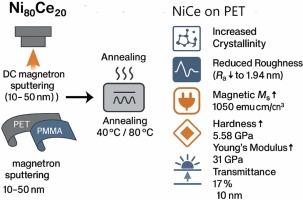退火温度和聚合物衬底类型对柔性电子产品用Ni₈₀Ce₂₀薄膜结构、磁性、机械和电性能的影响
IF 6.3
2区 材料科学
Q2 CHEMISTRY, PHYSICAL
引用次数: 0
摘要
在室温(RT)下,通过直流磁控溅射在聚对苯二甲酸乙二醇酯(PET)和聚甲基丙烯酸甲酯(PMMA)衬底上沉积了厚度为10 nm至50 nm的镍铈(Ni₈₀Ce₂₀)薄膜,然后在40℃和80℃退火。利用掠入射x射线衍射(GIXRD)、原子力显微镜(AFM)、磁力显微镜(MFM)、振动样品磁强计(VSM)、纳米压痕、霍尔效应测量和光学透射率等技术对薄膜进行了表征。XRD结果表明,在退火过程中,镍(Ni)(110)在PET上,NiCe(220)在PMMA上的结晶取向与基体有关。表面粗糙度随退火而降低,pet基薄膜的降低幅度更大。磁畴分析表明,磁畴结构由条状向波浪状转变,增强了磁畴稳定性。磁性能,包括饱和磁化强度(Ms)和矫顽力(Hc),随退火温度和衬底类型的不同而变化。力学性能,如硬度和杨氏模量,随薄膜厚度和退火而增加,厚度较厚的薄膜和在80°C退火的薄膜的数值更高。随着薄膜厚度和退火温度的增加,薄膜的电阻率和电阻率等电学性能有所降低,这主要是由于结晶度的提高和电子散射的减少。这些发现为研究退火和衬底类型对Ni₈₀Ce₂₀薄膜的结构、磁性、机械和电学性能的影响提供了见解,这些薄膜在柔性电子产品中的潜在应用。本文章由计算机程序翻译,如有差异,请以英文原文为准。

Influence of annealing temperature and polymer substrate type on the structural, magnetic, mechanical, and electrical properties of Ni₈₀Ce₂₀ thin films for flexible electronics applications
Nickel-cerium (Ni₈₀Ce₂₀) thin films with thicknesses ranging from 10 nm to 50 nm were deposited onto polyethylene terephthalate (PET) and polymethyl methacrylate (PMMA) substrates via direct current (DC) magnetron sputtering at room temperature (RT), followed by annealing at 40°C and 80°C. The films were characterized using various techniques, including grazing incidence X-ray diffraction (GIXRD), atomic force microscopy (AFM), magnetic force microscopy (MFM), vibrating sample magnetometry (VSM), nanoindentation, Hall effect measurement, and optical transmittance. XRD results revealed crystallization and improved atomic ordering with annealing, with a substrate-dependent crystallographic orientation observed nickel (Ni) (110) on PET and NiCe (220) on PMMA. Surface roughness decreased with annealing, more significantly for PET-based films. Magnetic domain analysis showed a transition from striped to wavy structures, enhancing domain stability. Magnetic properties, including saturation magnetization (Ms) and coercivity (Hc), varied with annealing temperature and substrate type. Mechanical properties, such as hardness and Young's modulus, increased with film thickness and annealing, with higher values observed for thicker films and those annealed at 80°C. The electrical properties, such as sheet resistance and resistivity, exhibited a decrease with increasing film thickness and annealing temperature, which can be attributed to enhanced crystallinity and reduced electron scattering. These findings provide insights into the influence of annealing and substrate type on the structural, magnetic, mechanical, and electrical properties of Ni₈₀Ce₂₀ thin films for potential applications in flexible electronics.
求助全文
通过发布文献求助,成功后即可免费获取论文全文。
去求助
来源期刊

Journal of Alloys and Compounds
工程技术-材料科学:综合
CiteScore
11.10
自引率
14.50%
发文量
5146
审稿时长
67 days
期刊介绍:
The Journal of Alloys and Compounds is intended to serve as an international medium for the publication of work on solid materials comprising compounds as well as alloys. Its great strength lies in the diversity of discipline which it encompasses, drawing together results from materials science, solid-state chemistry and physics.
 求助内容:
求助内容: 应助结果提醒方式:
应助结果提醒方式:


